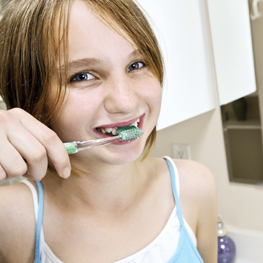
Teens are notorious for being image-conscious, so it’s not surprising that they often want to whiten their teeth, either at home or via appointments with a dentist. Parents may wonder if dental whitening is safe for adolescents. The answer is a guarded “yes.”
The American Dental Association (ADA) defines whitening as any process that will make teeth appear whiter, differentiating between bleaching products, which contain peroxide and actually change tooth color, and whitening toothpastes, which only remove surface stains. The ADA recommends that anyone who is thinking about bleaching consult a dentist.
Too young for bleaching?
When it comes to younger teens and tooth bleaching, the first concern is whether they have all their permanent teeth. If teens bleach their teeth before then, the difference in the thickness of enamel in baby and permanent teeth will cause uneven whitening. Trying to match tooth color later on when all permanent teeth are through may not work. Because of this danger, the American Academy of Pediatric Dentistry discourages cosmetic bleaching when anyone has a mixture of baby and permanent teeth.
Likewise, dentists caution that permanent teeth need to have fully emerged before bleaching is started. That’s so a teen doesn’t end up with teeth that are whiter at the biting surface and darker near the gum line.
Dr. Poonam Jain, a Director of Community and Preventive Dentistry and a dentist in private practice, says young patients and their parents often ask about bleaching when braces are removed. Others want to even out yellow spots or white blotches on teeth, a congenital condition.
Age 13 as a bleaching cutoff
Jain says she discourages bleaching completely before kids are at least 13.
“Even at 13 I’m concerned,” she says. “They have large pulp chambers - the chamber that carries the tooth nerve - because their permanent teeth have just come in. When the pulp chamber is large, the tooth becomes very sensitive when you bleach it. It can become throbbingly painful.” Jain suggests that parents “hold the child off for a bit, until they’re 14 or 15 years old.” She explains that the pulp chamber narrows with time, reducing the risk of extreme sensitivity during bleaching. Jain says it’s important to bleach under a dentist’s supervision. One reason for that is to avoid overbleaching.
“People think that if a little is good, more will be better,” she says, “and more can be very damaging. When someone keeps purchasing these over-the-counter products and keeps bleaching with no end, it can lead to erosion of the enamel.”
Teeth are yellow under their white enamel coating, explains Jain. Lose the enamel through overuse of caustic bleaching products, and you’ll be stuck with yellow teeth for all your life.
“You can’t keep bleaching for months or years on end,” Jain says. It’s very important to let kids know this.”
Individual assessment
Dr. Jack Ringer, dentist and President of the American Academy of Cosmetic Dentistry, agrees that a teen (or adult) should consult a dentist before bleaching. He says a dentist can give an individual assessment, determining, for example, whether a patient has surface stains that can be brushed off or whether they have dental restorations, such as fillings, that won’t bleach.
Ringer says teens need to understand options for bleaching – home methods, office methods or a combination of both – as well as their pros and cons. Even if someone wants to use only an accepted over-the-counter product, such as Crest Whitestrips, Ringer advocates consulting a dentist. That’s to make sure the teen’s teeth warrants that type of therapy and whether they are a good candidate for bleaching. Bleaching is safe, Ringer adds, as long as patients use approved products and have proper direction and supervision.
Avoid kiosk and infomercial products
He advises teens to avoid bleaching kiosks and infomercial bleaching systems. “Because the active ingredient in bleaching is not a prescription chemical, (i.e., a hydrogen peroxide derivative), TV-advertised systems, mall bleaching kiosks, etc., are able to market to the public, all with the message that it is as good or better using their products than going to a dental professional. This is particularly more dangerous for an impressionable teen who is looking for a quick and cheap alternative to whitening their teeth.”
Ringer warns against having preconceived notions regarding how white one’s pearly whites can become with bleaching.
“The one huge downside to bleaching teeth is that you can’t ‘order’ your color,” he says. “In other words, you get what you get.”
Ringer says teens should stop the bleaching process when they reach a tooth color they like or when lightening has plateaued. Stains will eventually return, but how quickly that happens depends on how often teeth are exposed to staining substances like coffee, tea, soda and cigarette smoke.
One way for teens to avoid soda-induced stains on front teeth: use a straw.
Barb is a freelance writer and mother of two who specializes in parenting issues and travel.
Calgary’s Child Magazine © 2024 Calgary’s Child